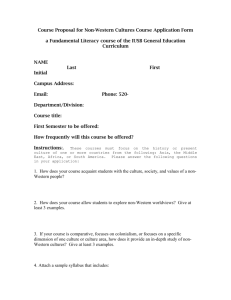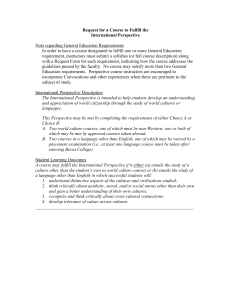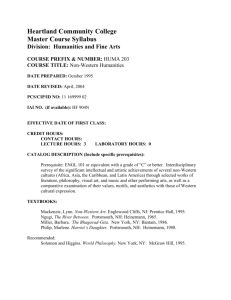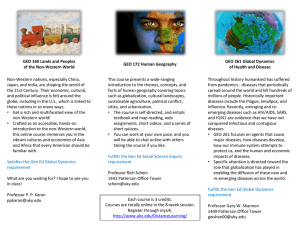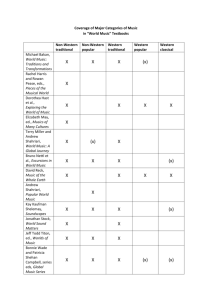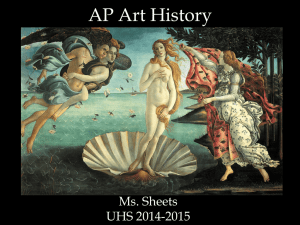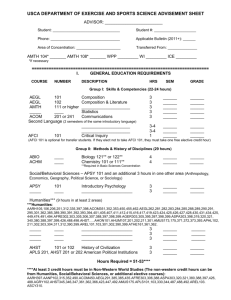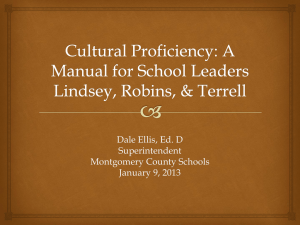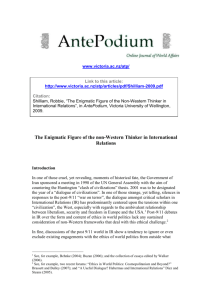Current Music of Non-Western Cultures: Indigenous, 21st Century
advertisement
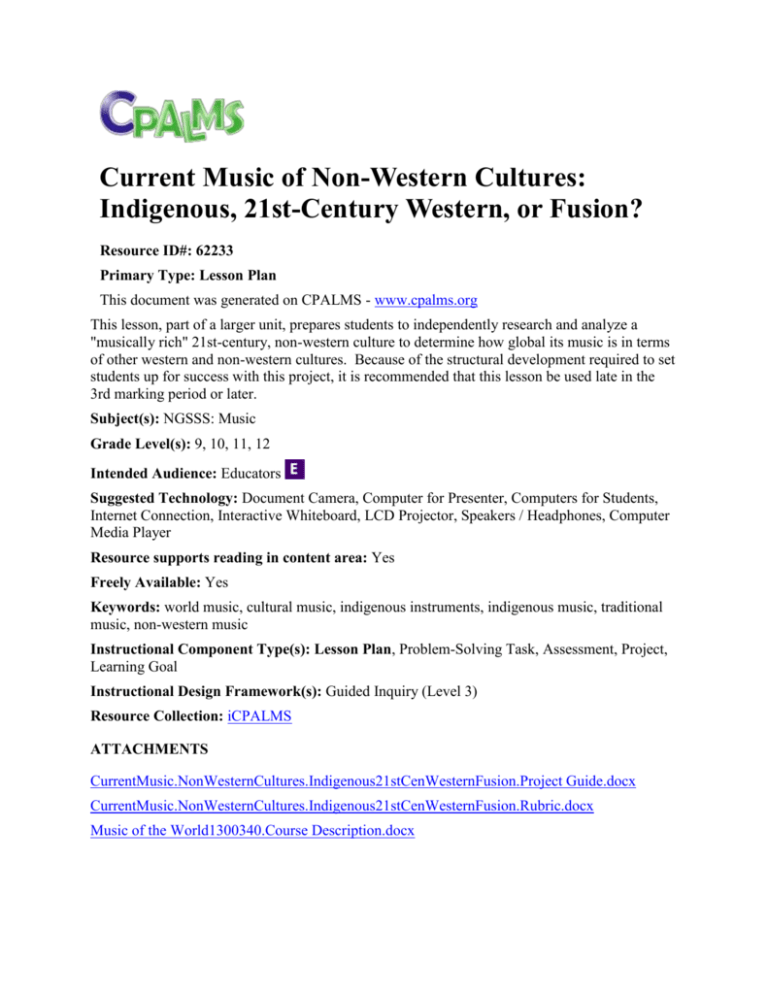
Current Music of Non-Western Cultures: Indigenous, 21st-Century Western, or Fusion? Resource ID#: 62233 Primary Type: Lesson Plan This document was generated on CPALMS - www.cpalms.org This lesson, part of a larger unit, prepares students to independently research and analyze a "musically rich" 21st-century, non-western culture to determine how global its music is in terms of other western and non-western cultures. Because of the structural development required to set students up for success with this project, it is recommended that this lesson be used late in the 3rd marking period or later. Subject(s): NGSSS: Music Grade Level(s): 9, 10, 11, 12 Intended Audience: Educators Suggested Technology: Document Camera, Computer for Presenter, Computers for Students, Internet Connection, Interactive Whiteboard, LCD Projector, Speakers / Headphones, Computer Media Player Resource supports reading in content area: Yes Freely Available: Yes Keywords: world music, cultural music, indigenous instruments, indigenous music, traditional music, non-western music Instructional Component Type(s): Lesson Plan, Problem-Solving Task, Assessment, Project, Learning Goal Instructional Design Framework(s): Guided Inquiry (Level 3) Resource Collection: iCPALMS ATTACHMENTS CurrentMusic.NonWesternCultures.Indigenous21stCenWesternFusion.Project Guide.docx CurrentMusic.NonWesternCultures.Indigenous21stCenWesternFusion.Rubric.docx Music of the World1300340.Course Description.docx LESSON CONTENT Lesson Plan Template: Guided or Open Inquiry Learning Objectives: What will students know and be able to do as a result of this lesson? Learning Goal (Posted on the wall for the Unit): We are learning about and sharing the current status of music in a specific non-Western culture of the world, as well as its status in Western music markets. Success Criteria (Posted with the Learning Goal): Select a musically rich, non-Western culture. Select a broad array of digital and print resources about the culture to gain an overview (e.g., political stability, socio-economic factors, religious freedom, freedom of speech, ease of access to technology and the Internet) and prepare an analysis of those effects on its musical past and present. Gather photographs (or links to same) and digital sound samplings of its indigenous instruments, categorizing them according to Western instrument categories and justifying the categorizations. Describe the traditional uses for music over time within the culture and address the effect of technology on both the music and its uses. Address the degree to which the culture embraces Western music, and the degree to which its instruments and/or music have been or are becoming infused in Western music. Analyze the degree to which there is evidence of fusion (or general modernization) within its own culture and address how technology is playing a role in that change. Lesson Objective (Posted on the wall for the Lesson): Students will: Complete preliminary organization, explore the depth of information available (including availability of digital visual and audio samples), and gain approval for the research project. Guiding Questions: What are the guiding questions for this lesson? Question for Investigation: In the 21st century, how “global” is music as it functions in non-western (or developing) cultures of the world? Guiding Questions: 1. What are the indications that a culture is "musically rich?" What could the term "musically rich" mean in a culture? 2. What factors strongly contribute to developments in a culture's music? 3. What purpose(s) does music serve for various segments of society in a culture? 4. How does technology affect non-western indigenous music and its relationship with music of other cultures, if at all? 5. What is the relationship between the indigenous musical instruments of a culture and instruments used in American and other western music? 6. How and why does borrowing or fusion of musical characteristics happen among cultures? Prior Knowledge: What prior knowledge should students have for this lesson? This lesson is part of a unit intended for use near the latter portion of the 3rd marking period, for completion by the end of the marking period. It is the most extensive research project to date for this class, and one students enjoy doing, because they're allowed fairly broad parameters in selecting the culture for study. In addition to serving obvious educational purposes within (#1300340) Music of the World, the procedures in this project also help set students up for success in completing their culminating project. The students have worked with the requisite structures for research projects throughout the year in increasingly independent increments. Content knowledge about cultural uses for and influences on music, indigenous music and instruments, etc. is also clearly required for students to enter into and complete this research successfully. Introduction: How will the teacher inform students of the intent of the lesson? How will students understand or develop an investigable question? Essential Question: In the 21st century, how “global” is music as it functions in Western and non-Western cultures around the world? 1. Review the Essential Question (EQ) as a guiding premise for this research project. The Learning Goal and Success Criteria, like the EQ, are posted in the room (see Project Guide). 2. Review the functions music generally serves in cultures around the world (e.g., cultural and historical preservation, rites, work, entertainment, protest, subterfuge). 3. The initial work is to A) investigate non-western culture choices for sufficient quantity and quality of available information, as well as for sufficient differences from western musical traditions and instruments over time; B) prepare and maintain a log of keywords used, noting how successful they are, and a log of print and digital media accessed (including URLs); and C) create a plan for completing the research, written, and presentation portions of the project. 4. Students should begin by reviewing their class notes for the names of nonWestern nations. Some may be so large and/or diverse as to warrant focusing on a particular region. A preliminary investigation, noting the items in Step #3, should provide a reasonable idea as to the quantity and quality of information, and whether the music and indigenous instruments are sufficiently different from those of Western cultures. The students should build their plans, maintaining the list of keywords, a list of works to be cited with brief (informal) annotations, URLs, discography, and other information, etc. 5. Before proceeding, the student must submit the plan with associated deadlines for each portion of the project and gain written approval from the teacher to move forward with the selected nation or region. Every effort will be made to avoid duplication of cultures. 6. When written approval is noted on the plan, students should begin making notes, collecting written citation information, and gathering digital photographs (or links) and sound samplings. Students will be encouraged to reference the handouts to maintain their focus and support note-taking. Investigate: What will the teacher do to give students an opportunity to develop, try, revise, and implement their own methods to gather data? Students will work independently, with guide-on-the-side conversations with the teacher and periodic deadlines for progress checks. One other important facet of this project is an occasional pause for small-group student-to-student checks. This allows students to share successes and concerns, roadblocks, and potential solutions, helpful resources, and more. Students will have full access to the Learning Goal, Success Criteria, and the Rubric (based on the Success Criteria) throughout the project to encourage deep student engagement, self-assessment, and individual "gap analysis." Analyze: How will the teacher help students determine a way to represent, analyze, and interpret the data they collect? This lesson addresses the preliminary investigation of a non-Western country, state, or region to determine its viability for study. The analytical and interpretive processes of this particular lesson will be limited to quantity and quality of print and digital information, including visual and digital samplings. The students' responsibility, in this lesson, is to provide adequate information to the teacher to ensure that the selected country, state, or region is a viable subject for study. Closure: What will the teacher do to bring the lesson to a close? How will the students make sense of the investigation? Before proceeding, the student must submit his/her plan with associated deadlines for each portion of the project and gain written approval from the teacher to move forward with the selected nation, state, or region. Every effort will be made to avoid duplication of cultures selected by the students. When written approval is noted on the plan, students will deepen their research, making more detailed notes, collecting written citations, and gathering digital photographs (or links) and sound samplings (or links). Students should reference the handouts to maintain their focus and support note-taking. ASSESSMENT Formative Assessment: The students have completed previous research in various forms, both as a means of gaining important course-specific knowledge and as a means of setting them up for success with this major project. Inquiry-based learning is a familiar and reasonably comfortable process for this group. Therefore, it is appropriate that the students be expected to perform at a reasonably independent level of inquiry once the initial parameters have been identified and discussed. Feedback to Students: The Project Guide includes both the Learning Goal and associated Success Criteria related to this project, and the classwork leading up to it. This information is posted in the classroom, as is the Essential Question that has engaged the students and guided their study throughout the year. The Rubric, linked in the Summative Assessment section, is also made available to students from the beginning of the project. Formative assessment includes teacher observation with note-taking regarding students' independent work; and subsequent guide-on-the-side conversations with students as they select the specific culture (non-western country, state, or region) for study, maintain a record of their work, and create a plan for the three major portions of the project. Students will complete both an analytical research paper and a multi-media class presentation to show and share knowledge of content. The teacher will hold systematic guide-on-the-side conversations with students as they identify the specific culture (non-western country, state, or region) for study, maintain a record of their work, and create a plan for the three major portions of the project provide regular opportunities for students to check on their progress, ask questions, and seek/receive feedback. Periodic status checks, at which points they will submit materials for brief written comments, will also allow students to learn how they are doing. One other important facet of this project is an occasional pause for small-group student-to-student checks. This allows students to share successes and concerns, roadblocks, and potential solutions, helpful resources, and more. Students will be able to use the feedback they gain from the teacher and their peers in an on-going manner. Summative Assessment: The guiding tool for final assessment is the Rubric, which is based on the Success Criteria. Students will self-assess, provide feedback on others' class presentations, and receive a final grade that is a weighted combination of the teacher's rubric-based assessment, the student's self-assessment, and an average of the class members' assessment of the student's presentation to them. ACCOMMODATIONS & RECOMMENDATIONS Accommodations: Students with special needs may be provided with assistive technology, additional time for guided research, or help with note-taking. Alternative forms of showing knowledge and understanding of the teacherprovided and guiding questions is perfectly acceptable, as appropriate to any given student's needs. This exceeds the legal or traditional definition of "special need," as some students may find it tremendously difficult to speak in front of the class, but could prepare for and manage a "gallery walk" style of presentation to small numbers of students standing or sitting at the same level. Students may need some assistance with organization of information. Software or techniques for such specific skills as taking and organizing notes may prove helpful and set students up for success now and in college or career. Students may need an extension of time for revisions, particularly in the more formal, written portions generally expected in this project. Extensions: 1. The students complete their research, analysis, and written material over a carefully focused and guided 4-6 days, depending on access to the media center and/or computer lab. Early submissions and revisions/re-writes will be strongly encouraged. 2. The students will then have 2-4 days to assemble their multimedia presentations for sharing in class and a total of 3 days for each student to present to his/her peers. The students should take notes and be responsible for information presented by other students so they may A) assess each presentation; B) be assessed on others’ project content, and; C) participate knowledgeably in class discussions. Suggested Technology: Document Camera, Computer for Presenter, Computers for Students, Internet Connection, Interactive Whiteboard, LCD Projector, Speakers / Headphones, Computer Media Player Special Materials Needed: Student access to print and digital research tools (computers or suitable alternatives, as available and allowed by policy) Student access to presentation software with digital media linking capabilities Project Guide Project Rubric Further Recommendations: The structuring of research experiences prior to this project needs to be positive and incrementally logical, each step setting students up for success at the next level. The overall environment for this class absolutely MUST include two primary characteristics: 1. Mutual respect among all constituents 2. The "safety" (trust) required for students to be willing to take creative risks SOURCE AND ACCESS INFORMATION Name of Author/Source: Linda Lovins Is this Resource freely Available? Yes Access Privileges: Public License: Attribution-NonCommercial 3.0 Unported Related Standards Name MU.912.C.1.3: Description Analyze instruments of the world and classify them by common traits. Remarks/Examples: e.g., classical and folk instruments from around the world Investigate and discuss how a culture’s traditions are reflected through its music. MU.912.H.1.1: MU.912.H.2.4: LACC.910.SL.2.4: LACC.910.WHST.3.7: Remarks/Examples: e.g., patriotic, folk, celebration, entertainment, spiritual Examine the effects of developing technology on composition, performance, and acquisition of music. Present information, findings, and supporting evidence clearly, concisely, and logically such that listeners can follow the line of reasoning and the organization, development, substance, and style are appropriate to purpose, audience, and task. Conduct short as well as more sustained research projects to answer a question (including a self-generated question) or solve a problem; narrow or broaden the inquiry when appropriate; synthesize multiple sources on the subject, demonstrating understanding of the subject under investigation.
